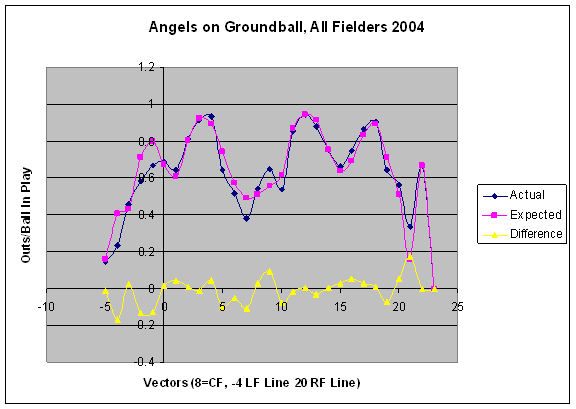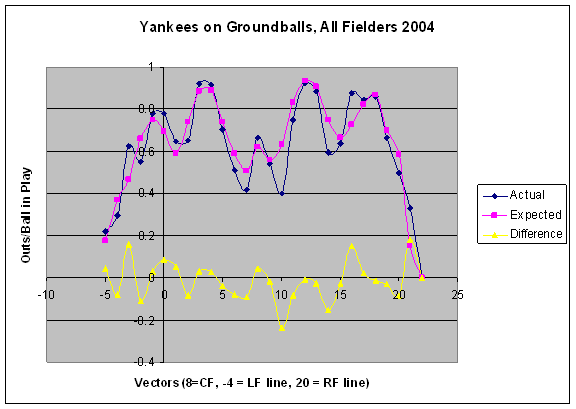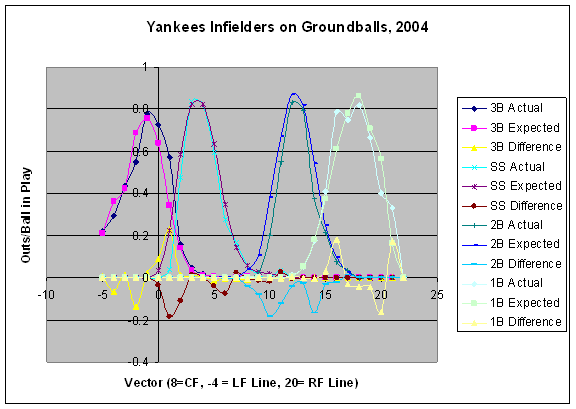 |
 |
|
March 28, 2005
Team Charts
With the introduction of a graphical representation of the Probabilistic Model of Range for players, I've had a couple of requests for entire infields, specifically the Angels and the Yankees. I'm presenting the charts for groundballs in two ways:
Note that I don't break it out by individual players; it's all shortstops for a team or all third basemen for a team. Without further ado, here are the charts for the Angels and Yankees. (Click on graph for a clearer view.) One example of how to use these charts is to look at the hole between third and short for the Angels, vector 1. The Angels as a whole are above average here, but it's due to the third basemen being way above average, while the shortstops as a whole are below average. The other thing these graphs are telling me is that I don't have park effects right. The expected curves for the two teams mostly look as they should; They have four humps representing the straight-away position of the fielders, the places where you would expect the most outs. But the Angels have a big hump down the right field line; the Yankees have a smaller hump up the middle. There's no reason for me to believe that a ground ball down the line is easier to field in Anaheim than anywhere else in the majors. Even though the data is smoothed (1/2 without park effects, 1/2 with) it's obviously not enough. I'll be persuing other ways of dealing with park effects in the near future. Baseball Musings is holding a pledge drive during March. Click here for details. Comments
Suggestions on presentation 1) ditch the grey background - it's chart junk. If you need the contrast, use light grey 2) Solid lines 3) As before, numbers bottom and left, rather than at the axis 4) when breaking the curves out by position, use the same colors for each data series. Trust the picture to tell the story. 5) Field landmarks, rather than vectors, as labels 6) Kill the dots that mark the datapoints, they aren't adding anything. I'm hoping you'll publish these for the rest of MLB as well. Posted by: Danil at March 28, 2005 03:53 PMInteresting to see that for the Yankees, the SS weakness is a 3B strength. ARod gets all the balls to his left, which kinda makes sense since it's easier for him to make that play. Plus ARod is a better fielder than Jeter. Posted by: sabernar at March 28, 2005 04:18 PMDavid-- forgive me if this is a stupid suggestion. I'm not clear on what data/method you used to figure park effects; but if you used actual events rather than theoretical models, is it possible that _everybody_ positions their fielders to guard the line more often in Anaheim than elsewhere, not making the ground ball there "easier to field," but rather "more often fielded"... and producing your "hump?" That is, while the "score" of the defenses at the humps is low, the contour of the "actual" line tends toward conformity-- would that happen if the prediction were a glitch? Wouldn't it just be an "empty" peak if this were pure system error? Posted by: john swinney at March 29, 2005 02:36 AMJohn, I do use actual events rather than a theoretical model. It's possible that every one in Anaheim guards the line, but it's also possible that the Angels guard the line everywhere much more than other teams. It may not be a park effect, but a team effect. Posted by: David Pinto at March 29, 2005 07:46 AMThen David-- stretching out to where the theoretical gets even thinner-- is it possible that the Yankees cheat their middle infielders toward second in double play situations, and so run them right into balls hit back throught the middle, creating "extra" outs in a lump there? Or perhaps the Yankee staff fields grounders through the box poorly leaving more chances for Jeter and Cairo or whoever? Or a combination of the two? The impressive thing to me about your charts is their isomorphism to real players and real actions and reactions. I'm sure there will be tweaks needed, but you are breaking new ground here--it may be easy to mistake information for noise for a while. I'd be very surprised if your stuff doesn't show us all sorts of things we haven't been spotting up to now. Perhaps not here-- but we may be blind men describing an elephant for a while... it might be good to walk around it a few times before deciding which end to feed and which to shovel... Post a comment
|
|






